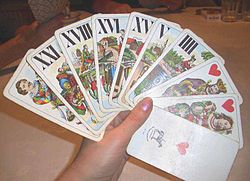Königrufen
| A trick-taking game of the European Tarot card game family. |
 |
| Origin |
Austria |
| Type |
Trick-taking |
| Players |
4 |
| Skills required |
Tactics, Strategy |
| Age range |
12+ |
| Cards |
54 |
| Deck |
Industrie und Glück |
| Play |
Counter-clockwise |
| Card rank (highest to lowest) |
Trump suit: Sküs, 21-1
Black suits: K Q C J 10 9 8 7
Red suits: K Q C J 1 2 3 4 |
| Playing time |
30 min. |
| Random chance |
Moderate |
| Related games |
| Tapp-Tarock, Cego |
Königrufen or Königsrufen ("The Calling of a King" Tarock) is a trick-taking card game four-player variant played in Austria and nearby areas in Central Europe, especially in Slovenia. Also five players may play the game with the dealer sitting out.
Austrian Königrufen has a common core set of rules with considerable variation in the types of announcements and bonuses permitted, along with scoring, with most groups of players creating their own house rules. Although widely accepted tournament rules have been developed, such rules vary depending on the region where the game is played.
History
Königrufen evolved from the older 18th century tarock games which borrowed their concepts of bidding from the card game Quadrille, an Hombre variant, to determine who played with whom. The earliest reference of the game appears in Wien, in a book written in 1840. Its closest cousin is Tapp-Tarock, extensively played in Austria.
Description
The 54-card Industrie und Glück Tarock deck with combined value of 70 points is used. Each player receives 12 cards and 6 cards called the Talon are placed in the center. Players take turn in a counter-clockwise direction. After the exchange with the Talon, the player to the right of the dealer leads to the first trick. Like most trick-taking games, the winner of the last trick leads to the next until either all 12 tricks have been played, or a player has failed to achieve an announced goal.
The cards
The 54 cards are divided into two groups: 32 suit cards and 22 Tarocks (trumps).
The 32 suit cards consist of four courts: king, queen, knight and jack, along with four lower ranked cards, the pips of eight cards each in the four suits: hearts, diamonds, spades and clubs -. The cards rank as follows:
- In black suits: king, queen, knight and jack 10, 9, 8 and 7
- In red suits: king, queen, knight and jack, 1, 2, 3 and 4.
The 22 Tarocks are ranked according to the Roman numbers displayed on the corner of these cards. Six Tarocks are specially named as they play important roles in the game:
- I - Pagat
- II - Uhu
- III - Kakadu
- IIII - Marabu
- XXI - Mond (The Moon). It is derived from the French Monde (The World).
The 22nd Tarock is unnumbered and depicts a harlequin is often called the Sküs, Gstieß, or a number of other phonetic derivations of the French "Excuse"
The Sküs, Mond and Pagat are called the Trull (derived from the French "tous les trois" or "all the three"). Tarocks II, III, and IIII are called Vogel ("Birds").
Game bonuses
Vogel (The Birds)
The birds are the lowest Tarocks:
- I - Pagat (The Acrobat). Also: Spatz (Sparrow)
- II - Uhu ( Eagle Owl).
- III - Kakadu (Cockatoo). Also: Pelikan (Pelican), Kanari (Canary), Cohn (?), etc.
- IIII - Marabu (Marabu Stork). Also: Quapil (?), Lämmergeier (Bearded Vulture), Wildsau (Boar), etc.
The Pagat is a special "Bird" as it also belongs to the Trull
The birds count as bonuses, if they win the appropriate trick. The Pagat must be won in the last trick, the Uhu in the penultimate, the Kakadu in the third to the last, and the Marabu in the fourth to the last. In the variant of the rules played in Cheltenham, the Marabu bonus trick is not played.
They must win the trick if they are to count as bonuses. Even if the taker's partner captures a bird Tarock, the bonus is lost and counts as negative. They are also lost if they are announced and not successfully achieved.
King Ultimo
The King Ultimo bonus is scored, if the called king wins the last trick. The bonus is also scored if the taker's partner takes the called king in the last trick.
Mondfang (capture of the XXI)
Mondfang is scored if the second highest Tarock (the Mond or XXI) is taken by the highest (the Sküs).
Read more:
COMMENTS








